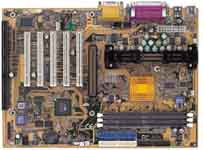VIA's KX133 is the clear choice for an Athlon chipset at this point in the game. Its support for AGP 4x and PC133 SDRAM are its biggest features - features that allow it to push ahead of the AMD 750 "Irongate" in virtually all performance related aspects. From a motherboard manufacturer's perspective, the KX133 also helps reduce manufacturing costs thanks to the ease of designing a 4-layer PCB with this chipset and the level of integration offered by the VIA 686A South Bridge, one of the components of the KX133 chipset.
While we saw only a few manufacturers producing boards for the Athlon at first, this is quite possibly due to the AMD 750 chipsets more complex design requirements. Now that the KX133 is here and shipping in full volume, we're seeing a flood of motherboard manufacturers jump on the Athlon bandwagon.
Gigabyte is one motherboard company that has been there from the beginning of the Athlon craze with the GA-7IX that was based on the AMD 750 chipset. Will that experience help them edge out everyone else in the race to make the best KX133 motherboard?
|
Motherboard Specifications |
|
| CPU Interface |
Slot-A
|
| Chipset |
VIA KX133
|
| L2 Cache |
N/A (on-chip)
|
| Form Factor |
ATX
|
| Bus Speeds |
100
/ 110 / 115 / 120
124 / 129 / 133 / 138 / 143 |
| Voltages Supported |
Auto Detect
|
| Memory Slots |
3 168-pin DIMM Slots
|
| Expansion Slots |
1 AMR Slot
1 AGP Slot 5 PCI Slots (3 Full Length) 1 ISA Slot (0 Full Length) |
| Onboard Sound |
Analog
Devices AD1881 AC 97
Creative CT5880 PCI Sound (optional) |
| BIOS |
AMI Simple Setup 1.20C
Gigabyte DualBIOS |
The Good
The GA-7VX is actually Gigabyte's second entry into the quickly growing VIA KX133 based Athlon motherboard market. It is the standard ATX version of the GA-7VM microATX KX133 board we looked at in our March 2000 Athlon Motherboard Roundup and includes a few new features not found on that more cost conscious board. Those features include Gigabyte's DualBIOS and true hardware based PCI sound. As a result of the standard ATX format, there are more expansion options. The 5/1/1/1 (PCI/AGP/ISA/AMR) slot configuration is unique, not for its number of slots, but for the shared AMR/ISA slot. Despite its rarity, we'd still like to see a 6th PCI slot on any newly released motherboard.
Their DualBIOS utility means there is actually a backup copy of the BIOS on the motherboard. If there is corruption in the main BIOS for any reason, the backup BIOS takes over to allow the system to boot. With viruses beginning to attack the BIOS and the possibility of failed flashes, DualBIOS is a good safe guard measure that you'll see more and more manufacturers implement on their boards.
The optional hardware-based PCI sound comes in the form of the Creative Labs CT5880 chip mounted just behind the PCI slots. We see this chip on a number of motherboards and it provides good basic sound acceleration that is far better than the AC'97 software CODEC that has become virtually standard on any new motherboard. Drivers are available for the CT5880 under Windows 9x, Windows NT 4.0, Windows 2000, Linux and even BeOS. Gamers looking for a full 3D positional sound solution should look elsewhere, however.











0 Comments
View All Comments